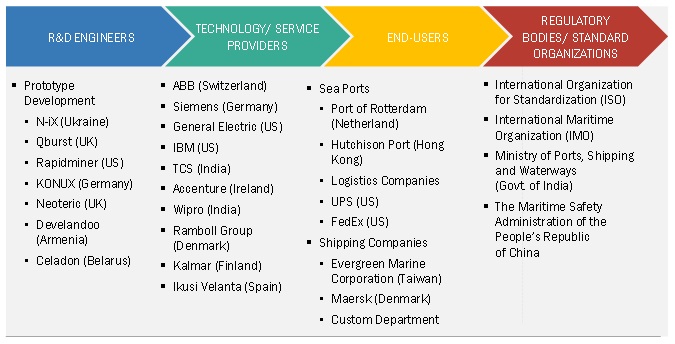Global Smart Port Market Size, Share and Industry Trends
Growing maritime trade activities internationally across industries, Growing decarbonization of the maritime industry which increases the health benefit and reduce carbon emission globally, hence these are driving the demand for smart ports globally. As the real-time geospatial data improve a large number of port operations such as it improved the freight operations by increasing visibility and assisting shipping companies which will help to navigate the current supply chain and it helped to grow the smart port market. Moreover, the fourth industrial revolution, referred to as Industry 4.0 (4IR), is the cyber-physical transformation of manufacturing also creating demand for the smart port as the primary application of 4IR was for smart factories so it will help in increasing the demand for the smart port market. An example of 4IR technology used in the ports is Dongwon Global Terminal (DGT) which is selected for CyberLogitec’s terminal operating system (TOS) so it is used for fully automated Busan New Port terminal, with using current technology such as Big data and Internet of Things (IoT). As the government initiatives in the development of smart port infrastructure which is made to opportunities for growth of the smart port market. In the current scenario as new technology develops so it was helping to upgrade the existing port with a large amount of development in the new port. As per this opportunity, the European Union (EU) is involved to upgrade and developing new ports because of commodities that are imported and exported, and around exchange within the EU.
Smart Port Market Overview
The global smart port market is expected to grow from an estimated USD 1.9 billion in 2022 to USD 5.7 billion by 2027, at a CAGR of 24.3% during the forecast period.
Key Market Players
The leading players in the smart port market include ABB (Switzerland), IBM (US), Siemens (Germany), General Electric (US), and Accenture (Ireland) Growth strategies adopted by these players include acquisitions, product launches, and contracts to increase their presence in the global market.
Download PDF Brochure – https://www.marketsandmarkets.com/pdfdownloadNew.asp?id=165784113
The throughput capacity segment is expected to be the largest and fastest growing market, of extensively busy ports, during the forecast period.
There are three types of throughput capacity segments such as extensively busy ports, moderately busy ports, and scarcely busy ports. As the extensively busy ports handle a capacity of more than 19 million TEU per year. There is some region in which there are some ports globally that come under extensively busy ports such are the region China, Singapore, & South Korea which are the major corridor for trade activities. These ports have the smart infrastructure and have made significant investments in port features such as terminal automation, cargo handling, port community systems, smart infrastructure, and safety and security.

The Asia Pacific likely to emerge as the largest smart port market
The Asia Pacific region accounted for the largest share of the smart port market in 2021. The region is experiencing rapid development fueled by the growth of major economies, such as China, Singapore, India, South Korea, Japan, Hong Kong, Indonesia, and Australia. It is a dominant region in the smart port industry. It is also considered a lucrative region for maritime trade. As the increase in seaborne trade has subsequently led to an increase in demand for ships that are used to transport manufactured goods to various regions globally. The growth of the smart port industry decreased as a result of the Covid-19 pandemic in 2020 which directly impacted this region, which declined by around 1.5% in 2020. The rise in the number of ships will contribute to the growth of propulsion systems and engines in the Asia Pacific region. As per the Journal of Commerce’s annual list of the top 50 container ports in the global in these Asia Pacific has been ranked the 9th out of the 10. Regarding port development, the ports in these regions have grown in tandem with the economic development of most countries which reflecting the region has the fastest economic growth. The Organization for Economic Cooperation and Development (OECD) projects that by 2050, the volume of maritime trade will have tripled, raising the demand for global freight. The Asia Pacific region has an increasing number of ports each year, and those that already exist are expanding. This is because the majority of cargo transit occurs via maritime routes. The program aims to boost the effectiveness of the regions current port facilities through automation, information technology, streamlining of work procedures, the use of new equipment, and employee training. It will help to grow in the smart port industry and drive forward.
Ask Sample Pages – https://www.marketsandmarkets.com/requestsampleNew.asp?id=165784113
Report Objectives
- To define, describe, segment, and forecast the smart port market by element, technology, throughput capacity, port type and region based on market size and volume
- To forecast the market size, in terms of value and volume, for five key regions: North America, South America, Europe, Asia Pacific, and the Middle East & Africa, along with their key countries
- To strategically analyze the subsegments with respect to individual growth trends, prospects, and contributions of each segment to the overall market size
- To provide detailed information about the key factors such as drivers, restraints, opportunities, and challenges influencing the growth of the market
- To analyze market opportunities for stakeholders and details of the competitive landscape for market leaders
- To strategically profile the key players and comprehensively analyze their market shares and core competencies
- To analyze competitive developments, such as sales contracts, agreements, investments, expansions, new product launches, mergers, partnerships, joint ventures, collaborations, and acquisitions, in the smart port market


